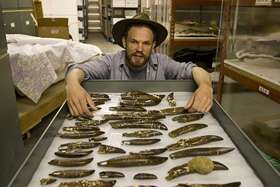Engineering a new way to see dinosaurs

With the eye of an electrical engineer, Nels Peterson is hoping to bring a new, high-tech tool to the field excavation of dinosaurs, a labor of picks, shovels and brushes that has changed little over the past 100 years.
"Only a small group of people ever get to excavate a particular dinosaur," said Peterson, a 2005 electrical engineering graduate from Montana State University. "An excavation is like being in the audience of a Shakespeare play. For those who weren't there, they have to read the play or, worse, read a review. A lot of information is lost. I'm trying to bridge that gap."
Peterson has been working with paleontologist Jack Horner at the Museum of the Rockies since he was an undergraduate. During this summer's field season, Peterson will experiment with a method he developed to use LIDAR (light detection and ranging) for creating 3-dimensional computer models of dinosaur bones as they are excavated. Researchers could then examine the computer model from any angle and have a record of the sedimentary layers in which the fossil was encased.
"When we excavate a dinosaur, we're trying to preserve a story," Peterson said. "We already have a pretty good idea of what dinosaurs looked like. But the way the bones are in the ground may tell us something about how they lived and died. Currently, we lose a lot of that story in excavation."
His innovative approach to paleontology garnered him one of ten profiles on 'dream jobs' in the February issue of Spectrum, a professional engineering magazine.
Peterson's personal interest in dinosaurs began when he was eight. While digging a play fort, he and a friend unearthed a pig skeleton near his father's auto-repair shop in Corvallis, south of Missoula. The site had formerly been a cheese factory where excess whey was fed to pigs.
"We got this skull. It was huge to us. It had tusks," Peterson said. "We were sure it was a dinosaur."
His professional start with paleontology began when he was looking for a senior design project and asked Horner if there was something the dinosaur hunter wanted built to help with excavations.
Initially, Horner said no, but later he asked Peterson if he could build a CAT scanner to look inside fossilized bones in a laboratory. Though Peterson figured he could build one, he came up with a far cheaper alternative -- to buy a used CAT scanner. Since it was the size of a truck, Horner passed. However, he did invite Peterson to a dig.
"At first, I was just a person who hauled things around and dug holes," Peterson said. "From then on it just got to be a bad habit."
Since then he has become an integral part of Horner's field operations overseeing the quality of fossil collection, preservation and record keeping in the field. He also repairs everything from vehicles to satellite communications and lends his 6-foot-8 frame to cooking, digging, setting up tents and pretty much anything else that needs to be done around camp. Horner offered him a full-time job when he graduated in 2005, but Peterson wanted to keep one foot in the engineering world.
Brilliant, quirky and affable all describe Peterson, said Horner.
"I'm always looking for new methods of acquiring new kinds of interesting data concerning dinosaur fossils, and therefore have a need for someone with curiosity and ingenuity," Horner said. "Nels is just exactly the kind of person I need for the kinds of things I do."
In addition to the eastern Montana work, Peterson has assisted digs in Mongolia and Niger. The latter was with Paul Sereno, of the University of Chicago, in unearthing a 12-meter-long "supercroc" that lived 110 million years ago.
In 2000, Peterson helped Horner unearth the 68-million-year-old Tyrannosaurus rex known as B. rex that has yielded one of paleontology's biggest finds -- intact protein. The fossil was buried 47 feet deep, and its excavation was one of the largest in the world.
During the winters, Peterson can be found in Boston where his wife, Laura Loge, is training to be an opera singer at the New England Conservatory of Music. Peterson fills his time with projects at MIT's Center for Bits and Atoms, an engineering workshop, where he has guest access.
"He's an amazing fellow," said Steve Shaw, an MSU electrical engineering professor who employed Peterson for three years as an undergraduate for research on fuel cells.
"He's been one of the highlights of my time at MSU," Shaw said. "I think he's taken every course on campus and may know more than some professors, but if you want him to keep working on something you have to keep him interested. I always joke with him that it took him about 15 years to graduate."
Actually, it took Peterson seven years to finish his undergraduate degree.
"I'm very easily distracted, and I tend to find my own way," Peterson said. "I feel bad for the teachers who had me."
Asked what career he'd like to ultimately find himself in, Peterson paused for a moment.
"I don't have an answer to that question," he said. "I just want to be around people who are smarter than me. Lots of people go into engineering because they want to make money, but that's never been my reason. I'll eat rice and beans so long as I can see the world in a new way and do interesting things."
Source: MSU




















